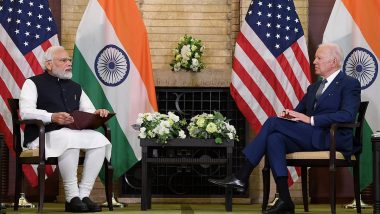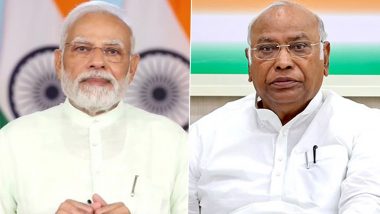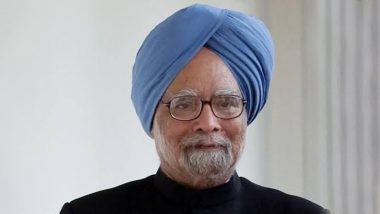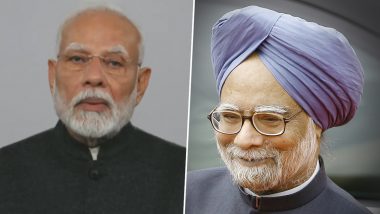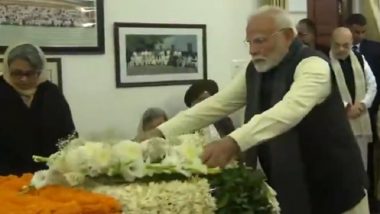Tokyo, May 24: Prime Minister Narendra Modi on Tuesday gifted a Sanjhi Art panel to US President Joe Biden during his meeting with him in Tokyo. Sanjhi Painting is a tradition of art that originated out of the cult of Krishna and flourished in the north Indian state of Uttar Pradesh. It is in Vraja, or Vrindavan, the homeland of Lord Sri Krishna, that this art of Sanjhi painting reached its pinnacle.
Sanjhi is the art of hand-cutting designs on paper. Traditionally motifs from Lord Krishna's stories are created in stencils. These stencils are cut freehand using a scissor or a blade. The delicate Sanjhi is often held together by thin sheets of paper. PM Narendra Modi in Tokyo to Attend US President Joe Biden's Indo Pacific Economic Framework Launch, Meet Top Business Leaders.
This intricate Sanjhi Panel is famously based on the theme of Thakurani Ghat from Mathura by a National Awardee. This art painting is rooted in the folk culture of the region. It was taken to its glory by the Vaishnava temples in the 15th and 16th centuries. Sanjhi came to be regarded as a highly refined art form practised by the Brahmin priests. Presently, the art of Sanjhi painting is practised by only a select few and remains a living tradition only in some of the temples of India. One of these temples where Sanjhi painting still survives is the Radharamana temple of Vrindavan.
PM Modi and Biden had a warm and productive meeting. The meeting resulted in substantive outcomes which will add depth and momentum to the bilateral partnership.
The meeting marks a continuation of the regular high-level dialogue between the two Leaders who met in-person in September 2021 in Washington D.C and interacted at the G20 and COP26 Summits thereafter. Most recently they had a virtual interaction on 11 April 2022.
The two leaders welcomed the signing of the Investment Incentive Agreement which enables the US Development Finance Corporation to continue providing investment support in India in sectors of shared priority such as healthcare, renewable energy, SMEs, infrastructure etc.
Both sides launched an India-U.S. Initiative on Critical and Emerging Technologies (iCET) to facilitate outcome-oriented cooperation. Co-led by the National Security Council Secretariat in India and the U.S. National Security Council, iCET would forge closer linkages between government, academia and industry of the two countries in areas such as AI, quantum computing, 5G/6G, biotech, space and semiconductors.
Noting that defence and security cooperation is a crucial pillar of the India-US bilateral agenda, both sides discussed how they can further strengthen collaboration. In this context, PM Modi invited the US industry to partner with India to manufacture in India under the Make in India and Aatma Nirbhar Bharat or self-reliant India programmes which can be of mutual benefit to both countries.
Taking forward their growing collaboration in the health sector, India and USA extended the longstanding Vaccine Action Programme (VAP) until 2027 to continue joint biomedical research which had resulted in the development of vaccines and related technologies.
To bolster the strong people to people linkages between the two countries, PM Modi called for strengthening higher education collaborations which can be of mutual benefit.
The leaders exchanged views on regional issues of mutual interest including South Asia and the Indo-Pacific region, reaffirming their shared vision for a free, open and inclusive Indo-Pacific region.
PM Modi welcomed the launch of the Indo-Pacific Economic Framework for Prosperity (IPEF) and stated that India is ready to work closely with all partner countries to shape a flexible, and inclusive IPEF taking into consideration the respective national circumstances. The leaders agreed to continue their useful dialogue and pursue their shared vision of taking the India-US partnership to a higher level.
(This is an unedited and auto-generated story from Syndicated News feed, LatestLY Staff may not have modified or edited the content body)





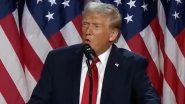







 Quickly
Quickly








